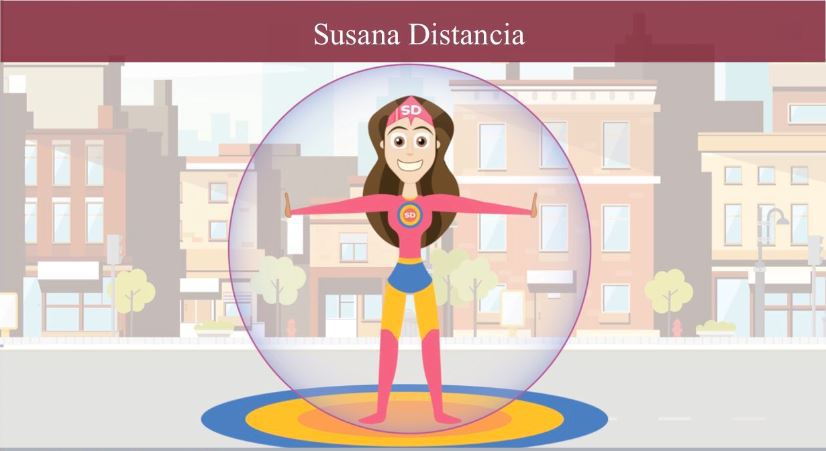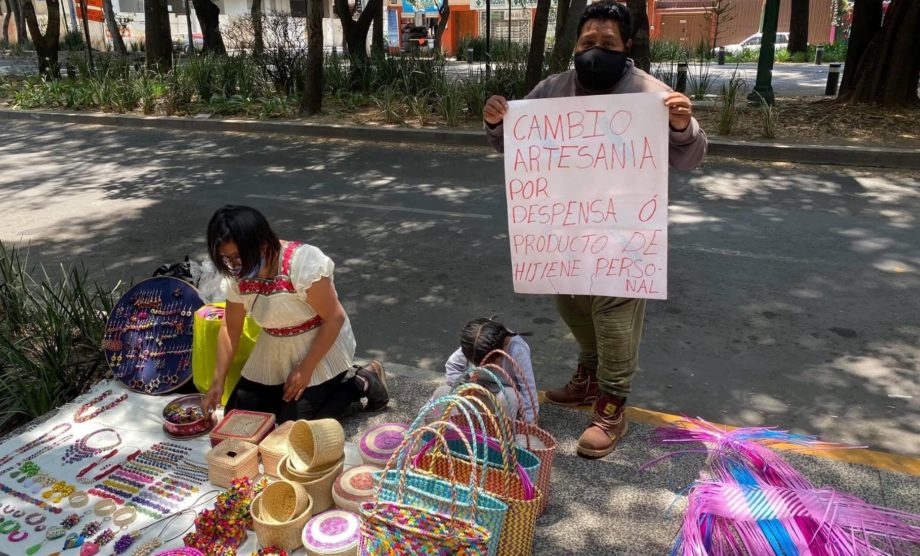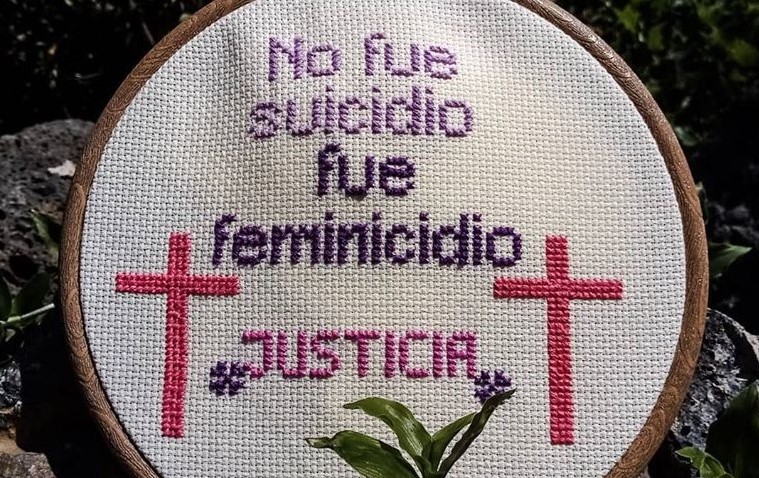Mixed Messages
COVID-19, a Cartoon Heroine, and Violence Against Women in Mexico
One of the gendered impacts of COVID-19 is the surge of violence against women and girls (VAWG) in many parts of the world as a result of lockdowns and stay-in-place orders (UN Women 2020). Using Mexico as a case study, I will address possible causes for the rise of VAWG during the current pandemic, and explore the Mexican state’s interventions as well as women’s response to them. My reflections take as a starting point the cartoon heroine Susana Distancia, who has become the central medium of Mexican health education about the coronavirus.
Historical and contemporary perspectives on COVID-19 in Mexico
It is a tragic historical coincidence that precisely 500 years ago, at the end of September 1520, smallpox, introduced from Europe, led to the first documented epidemic in the Americas. The center of the outbreak was the then flourishing capital of the Mexica empire, México-Tenochtitlan. According to the Spanish chronicler Fray Bernardino de Sahagún (1938: 85), the previously unknown pathogen rapidly spread through the densely populated city, killing thousands of its inhabitants. The devastating plague, which lasted for 60 days, had far-reaching consequences. It contributed to the fall of this political, religious, and economic center of the New World, which, in turn, opened the way for the subsequent conquest and colonialization of central Mexico (Crosby 2003: 47-50).
Since the beginning of the current health crisis, numerous controversies have been surrounding the government’s handling of COVID-19. These include the continuation of highly disputed mega-projects despite stay-in-place orders[1], the lack of access to water and medical care in rural and Indigenous communities, or politicians initially downplaying the seriousness of the pandemic[2], to name but a few. With a rising number of infections, the assessment of the country’s epidemiological profile has become the center of public attention. Instead of widespread testing and contact tracing, Mexican health authorities are relying on the so-called “sentinel model,” an epidemiological surveillance method based on a limited selection of reporting units. This model, as Vice Minister of Health Hugo López-Gatell recently admitted, may misrepresent data due to underreported cases.
Amid ongoing criticism and debate about the government’s handling of the health crisis, one of its public health interventions has turned into a success story: the comic heroine Susana Distancia (a wordplay in Spanish, that translates as “Your Healthy Distance”). Presented to the Mexican public on March 20 during the Health Ministry’s daily press conference, she has since become the colorful face of the national health campaign that educates the public and raises awareness about COVID-19 through television, the internet, posters, and WhatsApp.

Image 1: Susana Distancia. Source: Secretaría de Salud de México (2020).
Embedding Susana Distancia in Mexico’s social, cultural, and economic fabric
Susana Distancia owes her name to the government program Jornada Nacional de Sana Distancia (“National Day of Healthy Distance”), which comprises measures and recommendations to curb the spread of the coronavirus in the country. The enormous popularity, which the superheroine has gained within the last months, is most clearly reflected on social media platforms. By the time of this writing, her account has around 65,000 followers on Twitter and over 22,000 subscribers on Facebook, whose numbers are growing daily. She has also been the subject of numerous memes and a drawing contest on Instagram, which has drawn hundreds of entries so far.
As for the physical appearance of Susana Distancia, it bears a strong resemblance to the iconic US-American comic heroine Wonder Woman. Like her counterpart, she is of slim stature, has long brown hair and brown eyes. She wears a rose-blue costume and a headband, both displaying her initials. Depictions often show the superheroine with outstretched arms, surrounded by a transparent, violet bubble. Both iconographic elements illustrate the recommended minimum distance of 1,5 to 2 meters to reduce the risk of transmitting the virus from one person to another.
A look beneath the playful and colorful surface, however, reveals how the central message, the graphic design, and the gender of the health campaign’s centerpiece are embedded in and point to a broader context. For instance, the practice of social distancing promoted by the heroine echoes the government’s health policy strategy to cushion the national economy against the negative impacts of the pandemic. 31,3 million people, 56 percent of the country’s total working population, are employed in the informal sector (INEGI 2019). To avoid exacerbating the already precarious working and living conditions of many of these workers, Mexico, unlike other Latin American countries, did not impose a mandatory curfew. Yet, despite AMLO’s comparatively moderate course, the past few weeks have shown that particularly vulnerable groups such as daily wage laborers, urban-rural migrants, or small entrepreneurs have faced the loss of their livelihoods.

Image 2: A family offering handicrafts in exchange for food and hygiene products in the streets of Mexico City. Copyright: Maggie Urbina, published with permission (1 May, 2020).
A distinctive feature of Mexican health communication, which extends to the Susana Distancia campaign, is the frequent use of comics. According to Green and Myers (2010: 474), the advantage of this narrative media lies in the fact that “their powerful visual messages convey immediate visceral understanding in ways that conventional texts cannot.” Comics are, therefore, particularly appropriate for disseminating health information across different target groups and enhancing understanding. Their iconographic meanings reach adults and children as well as people with low literacy or different language skills. The latter two aspects are especially relevant in the Mexican context, which is characterized by linguistic and cultural diversity and an elevated illiteracy rate among the elderly (INEGI 2010).
According to Dr. Ricardo Cortés Alcalá, General Director for Health Promotion and Susana Distancia’s creator, the heroine also relates to the situation of many women in the country. In an interview, he highlighted Susana Distancia’s capacity to empower women “in […] Mexico, where there is still quite a high level of machismo” (El Universal 2020, translation by the author). The term machismo employed here is a veiled reference to the ongoing wave of gender-based violence that girls and women in the country continue to face. Last year alone, 2,822 women were murdered. Of these, 983 cases were officially classified as feminicidios (“feminicides”), raising their number by 137 percent over the last five years (SESNSP 2019).
COVID-19 and gender-based violence against women and girls
From January to early March 2020, VAWG dominated the news and public conversations, until it was overshadowed by the coronavirus pandemic. Two incidents that, due to their extreme cruelty, sparked particular outrage and further fuelled debates were the feminicides of 7-year-old Fátima Aldrighett and 25-year-old Ingrid Escamilla (Ojeda de la Torre 2020). In response to the government’s dismissive stance towards the issue, on 8 March, the International Women’s Day, around 80,000 women took to the streets in Mexico City alone to demand an end to VAWG and justice for the victims and their families. One day later, hundreds of thousands of women participated in a general strike called Un Día Sin Nosotras (“A Day Without Us”).

Image 3: Embroidery and photo by Akire Huauhtli, published with permission. The text reads: “It was not suicide, it was feminicide. Justice” (3 May, 2020).
Even though the public debate on VAWG came to a temporary halt due to the COVID-19 outbreak, the same event has brought it back into the spotlight. Since the beginning of the stay-at-home orders in March, emergency hotlines, the police, and women’s shelters are reporting a drastic increase in the number of calls. Furthermore, 665 women were murdered during this period, making the first half of the current year the most violent since statistics began in 2016 (SESNSP 2020). While these figures clearly indicate that the pandemic – including the state’s containment measures – have increased Mexican women’s structural vulnerability to gender-based violence, they leave unexplained the underlying causes of the recent trend. It seems likely that prevailing sociocultural norms and attitudes, which have fostered VAWG well before the current health crisis, are now intersecting with additional factors, thus reinforcing one another. O’Donnell, Peterman, and Potts (2020) identified several factors ranging from the offenders’ increased readiness to use violence (e.g. due to stress and fear caused by economic insecurity) to women’s restricted freedom of movement, and limited access to services and/or informal networks that provide support.
However, not only the actual causes but also the full extent of this so-called “other pandemic” in Mexico are unclear. For example, VAWG is notoriously underreported primarily due to stigma, feelings of shame, or fear of trivialization or reprisal. Therefore the majority of incidents are never brought to light. At the same time, an increase in calls and reports is not in itself an indicator that VAWG is intensifying, but could reflect rather women’s growing willingness to come forward (Htun and Jensenius 2020). This willingness has grown significantly among Mexican women over the last two decades (ibid.).
Susana Distancia and and the fight against VAWG: An outlook
Despite the popularity that Susana Distancia has gained in the last months, one question that remains unanswered is whether she has, indeed, the potential to contribute to women’s empowerment or whether she reproduces the stereotypical role of women as caregivers, as the following video illustrates.
Video 1: Susana Distancia – Salir a comprar (“Going out shopping”). Source: Secretaría de Salud de México (2020). https://www.youtube.com/watch?v=mJMkGoMmUAg
A discourse-analytical study of the Mexican COVID-19 health campaign and its reception could provide more in-depth information on this topic. Nevertheless, some provisional observations of the current protests against VAWG, and the state’s response to them, point to the difficulty in establishing the superheroine as an icon of female empowerment. So far, Susana Distancia is absent from feminist activism and awareness campaigns that have shifted to social media since the outbreak of the pandemic. In fact, women’s rights defenders and organizations are creatively appropriating the linguistic landscape of COVID-19. For instance, the hashtag #NoTeLavesLasManos (“Don’t wash your hands”) on Twitter highlights the personal responsibility of perpetrators and confidants on the one hand. The hashtag #QuédateEnCasaSinViolencia (“Stay at home without violence”), on the other hand, draws attention to women’s right to find a safe space in their homes in times of quarantine and isolation.
At the same time, recent state interventions convey the impression that Susana Distancia is merely a means of paying lip service to the government’s commitment to strengthening women’s rights, including responses to VAWG. Although support services for girls and women are considered essential in the latter endeavor, the government suspended funding of shelters for Indigenous and Afro-Mexican women amidst the pandemic putting many of these centers in peril of permanent closure (Murray & Lopez 2020). Besides, the political discourse continues to be characterized by purposeful ignorance and trivialization of VAWG. In response to the latest statistics, AMLO recently announced at a press conference that 90 percent of calls to VAWG helplines are “fake,” thereby denying the lived reality and credibility of the victims.
A second example of the government’s dismissiveness is the public awareness campaign against domestic violence Cuenta hasta 10 (“Count to 10”). The visual images and videos that comprise the campaign show families in daily scenes of domestic life that may cause intra-family conflicts. In order to prevent their escalation, the campaign’s recommendation is “to take a deep breath, count to ten, and raise the peace flag” (translation by the author). The most controversial image suggests that a woman is about to exert violence on a man.
The “Count to 10” campaign has proved to be rather short-lived. Presented to the public at the end of May, it instantly drew criticism, including from within the government, for depicting women as aggressors and reducing domestic violence and abuse to a mere lack of anger management (Verza 2020). After mounting pressure, Mexican officials withdrew the original campaign at the beginning of June. It is now modified and renamed #NoEstásSola. Llama al 911 (“#YouAreNotAlone. Call 911”) (SEGOB 2020).
Conclusion
In this contribution, I have reflected on the complex and multifaceted nature of the health heroine Susana Distancia, who plays a central role in Mexico’s public health education on the coronavirus. One defining feature of this highly popular cartoon figure is its deep rootedness in the country’s social and cultural fabric. In this context, I have traced Susana Distancia’s relation to VAWG and explored the current political discourse on the issue, which is characterized by ambivalence. The short- and long-term establishment of Susana Distancia as a symbol of Mexican women’s empowerment seems questionable when the dominant political discourse simultaneously diminishes or neglects the very existence of women’s rights violations such as VAWG. A comprehensive assessment of women’s social and health needs during this pandemic is crucial to the development of needs-based policies and programs for future events of this kind (Wenham, Smith, and Morgan 2020: 846). However, as the case of Mexico demonstrates, VAWG is a prevalent and systemic issue and therefore requires solutions beyond times of exception and crisis.
Acknowledgments
Acknowledgments are due to Gülay Ateş (Bonn University Clinic), Suparna Banerjee (Center for Development Research, Bonn University), Harald Grauer (Anthropos Institute), and the reviewers of the Blog Medizinethnologie for their insightful comments on earlier versions of this paper.
Written on 12 June 2020 and revised on 30 June 2020.
#Witnessing Corona
This article was simultaneously published on the Blog Medical Anthropology. Witnessing Corona is a joint blog series by the Blog Medical Anthropology / Medizinethnologie, Curare: Journal of Medical Anthropology, the Global South Studies Center Cologne, and boasblogs.
Catherine J. Letcher Lazo studied Cultural Anthropology at the University of Bonn, University of Hamburg, and Universidad Autónoma de Yucatán, earning her PhD from Bonn University. From 2017 to 2019, she was a postdoc researcher at the University Hospital of Bonn, where she studied cancer patient’s transition to palliative care. Other research focuses are language revitalization (Amerindian languages), the social construction of gender, and cultural models of health and sickness in South Mexico.
Email: letcher@uni-bonn.de
References
Aristegui Noticias. 2020. https://aristeguinoticias.com/1803/mexico/amlo-muestra-sus-escudos-protectores-video. Last access: 23/06/2020.
Crosby, Alfred W. 2003. The Columbian Exchange: Biological and Cultural Consequences of 1492 (30th Anniversary Edition). London: Praeger.
El Universal. 2020. Susana Distancia la heroína de la salud y del empoderamiento de la mujer. https://www.eluniversal.com.mx/nacion/susana-distancia-la-heroina-de-la-salud-y-del-empoderamiento-de-la-mujer. Last access: 20/05/2020.
Green, Michael J. and Kimberly R. Myers. 2010. Graphic Medicine: Use of Comics in Medical Education and Patient Care. In: British Medical Journal 340, 474-477. https://doi.org/10.1136/bmj.c863
Htun, Mala and Francesca R. Jensenius. 2020. The News Media’s Reporting on a Pandemic Spike in Violence Against Women. It Might Actually Be Declining. https://www.washingtonpost.com/politics/2020/04/24/news-medias-reporting-pandemic-spike-violence-against-women-it-might-actually-be-declining. Last access: 28/05/2020.
INEGI (Instituto Nacional de Estadística y Geografía). 2010. Censo de población y vivienda. https://www.inegi.org.mx/programas/ccpv/2010. Last access: 19/05/2020.
INEGI. 2019. Resultados de la encuesta nacional de ocupación y empleo. https://www.inegi.org.mx/contenidos/saladeprensa/boletines/2020/enoe_ie/enoe_ie2020_02.pdf. Last access: 19/05/2020.
Infobae. 2020. “No tren ecocida”: así protestaron los campesinos y activistas al megaproyecto de López Obrador. https://www.infobae.com/america/agencias/2020/02/22/protestan-en-mexico-contra-proyectos-de-infraestructura/. Last access: 24/06/2020.
Núñez, Efrain. 2020. Los pobres somos inmunes al coronavirus; afecta a los ricos: Barbosa. https://www.jornada.com.mx/ultimas/estados/2020/03/25/los-pobres-estamos-inmunes-de-coronavirus-barbosa-7821.html. Last access: 23/06/2020.
Murray, Christine and Oscar Lopez. 2020. Cutbacks in Mexico put Centers for Indigenous, Afro-Mexican Women at Risk. https://uk.reuters.com/article/mexico-indigenous/cutbacks-in-mexico-put-centers-for-indigenous-afro-mexican-women-at-risk-idUKL8N2DL68W. Last access: 10/06/2020.
O’Donnell, Megan, Amber Peterman and Alina Potts. 2020. A Gender Lens on COVID-19: Pandemics and Violence Against Women and Children. https://www.cgdev.org/blog/gender-lens-covid-19-pandemics-and-violence-against-women-and-children. Last access: 28/05/2020.
Ojeda de la Torre, Ivonne. 2020. La ira por los feminicidios de Ingrid y Fátima genera nuevas formas de protesta en Twitter. https://www.sinembargo.mx/18-02-2020/3732807 . Last access: 24/06/2020.
Sahagún, Fray Bernardino de. 1938. Historia de las cosas de la Nueva España. Tomo VII, Libro XIII. México D.F.: Editorial Pedro Robredo.
Secretaría de Salud de México. 2020. Susana Distancia. https://twitter.com/HLGatell/status/1241193159411064832?s=20. Last access: 23/06/2020.
SEGOB (Secretaría de Gobernación). 2020. #NoEstásSola. Llama al 911. https://twitter.com/SEGOB_mx/status/1268311387744411649. Last accessed: 25/06/2020.
SESNSP (Secretariado Ejecutivo del Sistema Nacional de Seguridad Pública). 2019. Información sobre violencia contra las mujeres. https://www.gob.mx/sesnsp/articulos/informacion-sobre-violencia-contra-las-mujeres-incidencia-delictiva-y-llamadas-de-emergencia-9-1-1-febrero-2019. Last access: 24/05/2020.
SESNSP. 2020. Información sobre violencia contra las mujeres. https://drive.google.com/file/d/1yVfgnItDgQC88zr2fnHW4lE8MwmzuPi0/view. Last access: 29/05/2020.
UN Women. Violence Against Women and Girls: The Shadow Pandemic. https://www.unwomen.org/en/news/stories/2020/4/statement-ed-phumzile-violence-against-women-during-pandemic. Last access: 23/06/2020.
Verza, María. 2020. Mexican Authorities Remove Controversial Domestic Violence Campaign That Depicted Women as Aggressors. https://www.eluniversal.com.mx/english/mexican-authorities-remove-controversial-domestic-violence-campaign-depicted-women. Last access: 30/06/2020.
Wenham, Clare, Julia Smith and Rosemary Morgan. 2020. COVID-19: The Gendered Impacts of the Outbreak. In: The Lancet 395 (10227), 846-848. https://doi.org/10.1016/S0140-6736(20)30526-2
Footnotes
[1] Two mega-projects that have been accompanied by protests for months are, for example, the Tren Maya in the state of Yucatán and the infrastructure program on the Isthmus of Tehuantepec (Infobae 2020).
[2] The governor of Puebla, Miguel Ángel Barbosa, was sharply criticized for the following statement: „If you are rich, you are at risk [of getting infected], if you are poor, then not. The poor, we are immune“ (Núñez 2020, translation by the author). Around the same time, President Andrés Manuel López Obrador (also known as AMLO) presented two amulets at a press conference refering to them as his „protective shields“ (escudos de protección) against the virus (Aristegui Noticias 2020).































